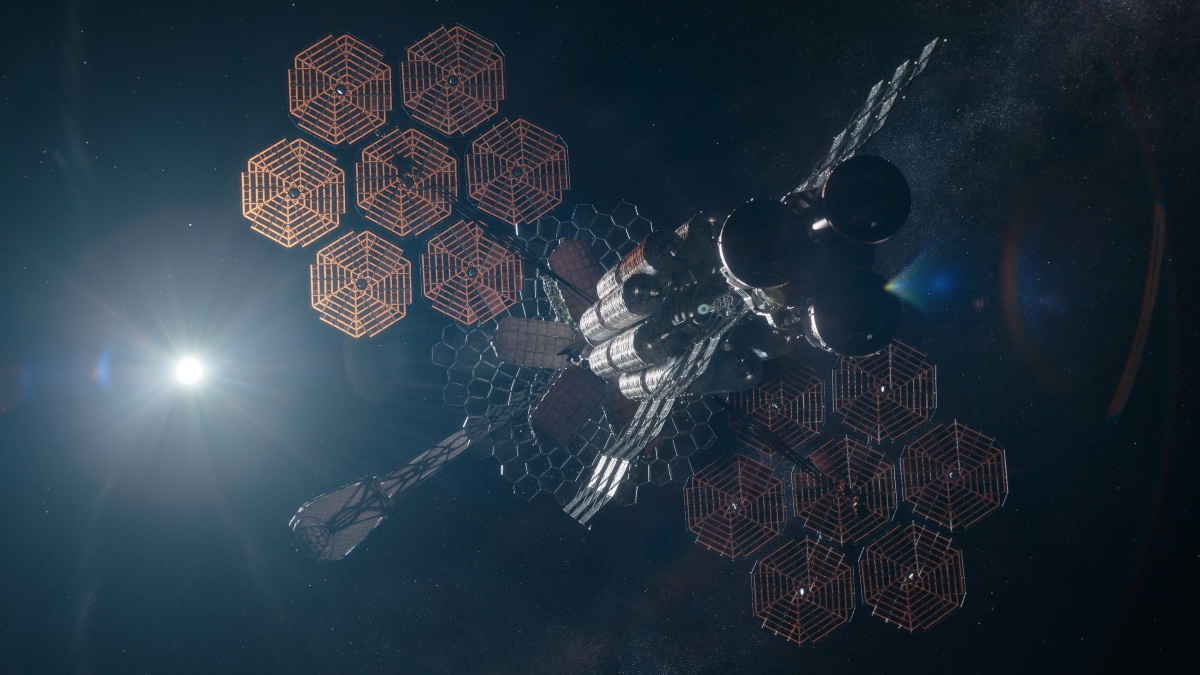
George Clooney’s The Midnight Sky, adapted from Lily Brooks-Dalton’s 2016 apocalyptic novel, Good Morning, Midnight, is the type of movie where you would expect there to be a lot of VFX.
From the harsh, windy and snow-swept Arctic environment where Clooney’s lone scientist Augustine is stationed, to the spaceship Aether, where some of the last remaining astronauts – played by Felicity Jones, David Oyelowo, Kyle Chandler, Demián Bichir and Tiffany Boone — are stationed, it’s an eye-catching visual spectacle.
Much of it is the work of Co-VFX Supervisors Matt Kasmir and Chris Lawrence, who previously worked on the visual effects for Clooney’s previous space-bound drama, Gravity. Despite it being fairly obvious for The Midnight Sky to be VFX-driven, many watching it might not realize how many aspects of the film relied on VFX.
Fortunately, Below the Line had a chance to speak with Matt Kasmir – unfortunately, Lawrence was indisposed at the time – for the following interview where we go into great depth on the visual effects for The Midnight Sky.
Below the Line: I know you and Chris worked on Gravity, but you were at different houses at the time, right?
Matt Kasmir: I’d actually just left Framestore, and I kind of helped out Tim Webber, who was the overall supervisor on it, prepping a lot of the material. We were both on that, and we’ve crossed paths a few times, because I’d been at Framestore for a long time when he started, so yeah, we have a lot of history.
BTL: Are you now George Clooney’s primary VFX guy, having done most of his last few projects?
Kasmir: Yeah, so I met him on that, and then the first film that I did on the client side was Suburbicon and then went from Suburbicon onto Catch-22, then from that onto Midnight Sky. It’s interesting, because he’d done a lot of these big budget, visual effects films. Distrust is the wrong word, but he had a slight… there was a black art, and because he’d worked on some of these larger films, he didn’t necessarily want people to just walk in and take over which he felt visual effects did to a certain extent. It has been known on some films. We walk in, and we call the shots, but this, he wanted very much to still be in a kind of filmic, filmmaking world where the camera ruled.
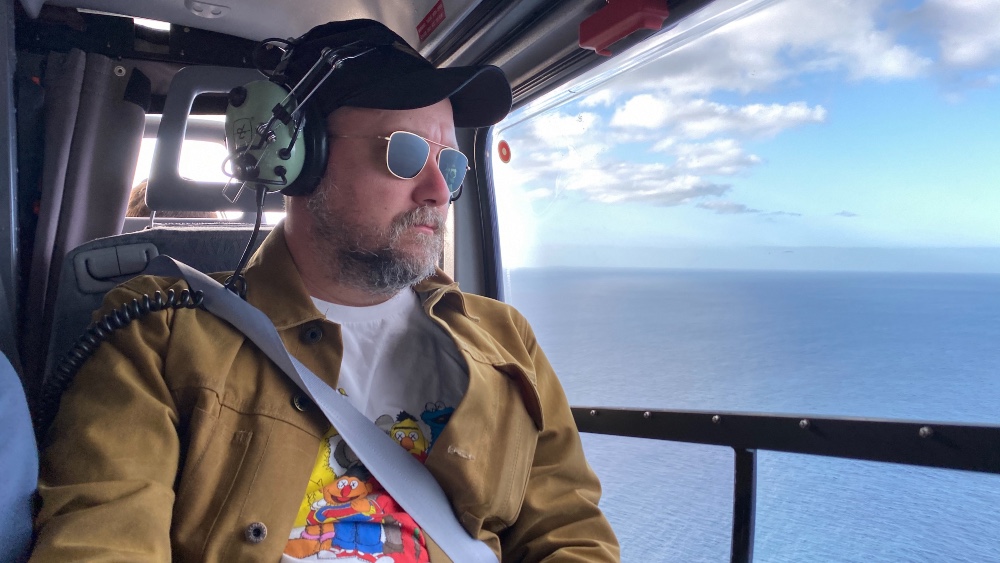
BTL: Working with Production Designer Jim Bissell, I think he mentioned that this was shot in 2018 some time?
Kasmir: Yes. The last job we did with Jim was Suburbicon, and Jim’s great. He’s a fantastic production designer, very talented. Apart from the obvious films like E.T., he also designed the Kentucky Fried Movie, which is really obscure but one of my favorite farcical films, and he’s great. I’ve always worked very closely with him, because I feel VFX… I mean, it’s a strange discipline, because we’re our own entity, but we also, by every right, tread on everyone else’s toes. It’s a continuation of production design, it’s a continuation of costume design, it’s a continuation of the camera, and everybody needs to feel confident with us. Jim is definitely quite forward thinking. Had it been a different production designer, we probably wouldn’t have used LEDs because we were using the LED walls before COVID. It obviously makes sense now, but Jim wanted them because it helped aid his production design. He wanted them, because he was building this fantastic set with these huge aspect windows, and it was highly reflective. If we had anything other than a Translight out there, it’s just gonna be dead, we’d be pulling information. We didn’t want to put a Translight out there because we’re meant to have these huge views, and there would be no parallax and the focus would be wrong. LEDs were the obvious choice, and he embraced that, along with the design of the [spaceship] Aether, too. He very much wanted to be involved, and he was hugely influential and did design the Aether.
We were lucky, we had an Art Director called Jonathan Opgenhaffen, who moved from Framestore into production design to help Jim design this. Occasionally, Jim would look around using our virtual camera system to check for scale, and we would kind of plot story beats where they needed to take place. So I mean, incredibly forward-thinking production designer who was also part of implementing all of these technologies we were using.
BTL: I’ve always known about the connection between production design and VFX and how important that relationship is, but I’m amazed by how many people in production design come from the world of VFX and vice versa. There seems to be a lot of crossover.
Kasmir: Absolutely. In fact, Jim has a really good saying, and it’s that he designs stuff to be made, whether it’s pixels or chipboard — it’s still created somewhere, and it’s still based on his designs. Likewise, just tipping slightly over the edge into costume design. I mean, Jenny Eagan was incredibly symbiotic in her relationship with Chris and I when it came to the design of the spacesuits. It’s very much her design, but she was acutely aware that we would end up digitizing most of it purely because a lot of the sequences that were taking place wearing the spacesuits were going to be zero gravity. So there was either going to have to be, at the very least, clean-up for wire fixing points, or fully taking over limbs to make them look a bit more Zero G. At first, I often find it awkward, because people are scared – and actors, too – are scared that you’re gonna steal or change their creative vision. Apart from anything else, I find it makes mine and Chris’ life so much easier if somebody else has ownership. I’m not a production designer. I can design something to fit into a production designer’s vision, and likewise with a costume designer, but I don’t want to spread myself thin and create everything.
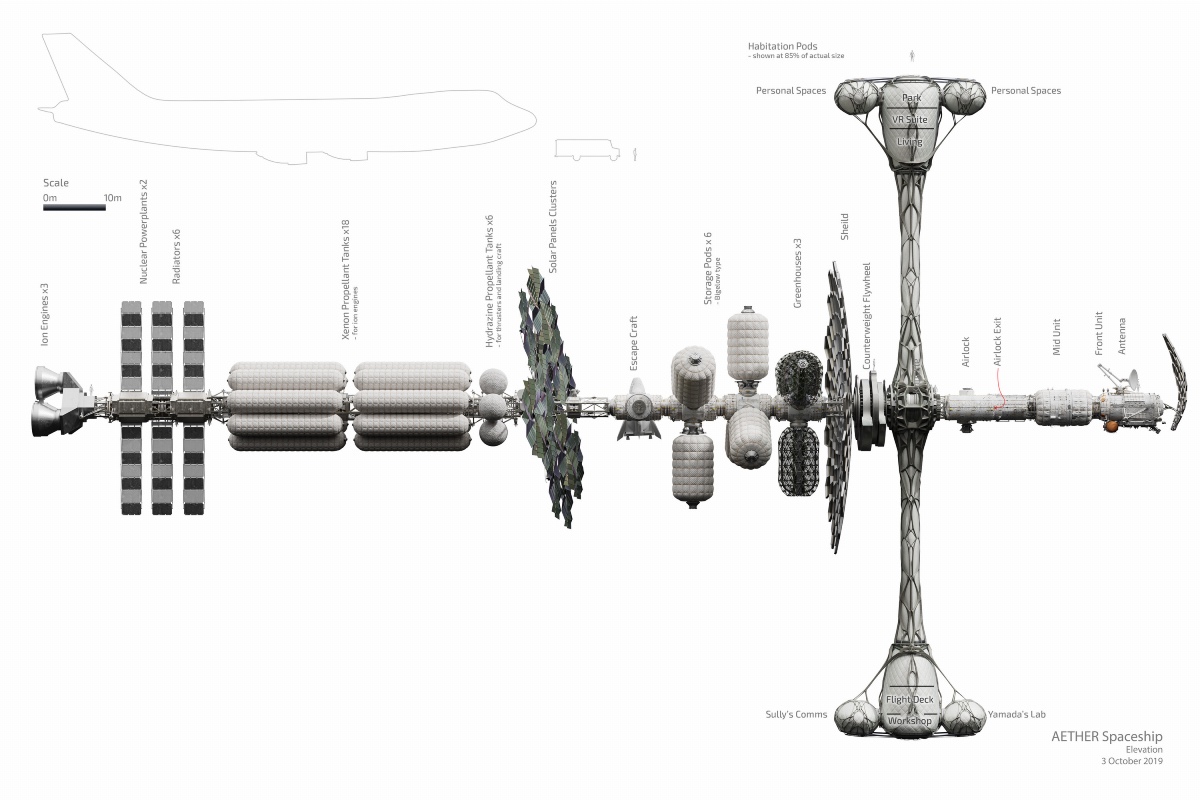
And that’s what we tried to do on Midnight Sky, full stop. Everything was there to try and lock in decisions during production. This is what the space looks like, this is what the spaceship looks like. This is what the Arctic looks like, through the windows of the Barbeau. Even with our Anyma Facial Capture System, it was still director and actor-driven. It was directed as any other scene albeit in an Anyma capture space. When we’re in post, there wasn’t the inclination to, “Oh, could you just edit their performance?” I was like, “No, we’ve got their performance. We can make a digital double from that performance, but it’s their performance.” Again, it’s this ownership that the various departments had, again, with [Cinematographer] Martin Ruhe, he had these beautiful detuned DNA signature lenses, and they’d flip the outer glass so that you’ve got – for lack of a better word – like a Jesse James fall-off in focus where towards the edge, you had a bell curve focus. So if you had two people standing next to each other, the one closest to the edge of frame would actually get soft, whereas the one in the center frame would be pin sharp.
And he said, “Can I shoot with these lenses on VFX shots?” and our opinion was, “Of course you can, because it’s your choice,” and it makes our life easier. Although we have to replicate it, it’s still a decision that’s been made. Could you imagine if we could create — and we can do anything from tilt shift to Jesse James, but it all just becomes a little bit funky when it’s in post. It’s more of a playground than a specific tool.
BTL: How much time did you actually spend on post after they finished shooting. Were you still doing the VFX on this when COVID hit or still tinkering?
Kasmir: Funny enough, we wrapped by March 18, and I flew straight to Los Angeles, and March 23, they said, “Well, maybe you should fly home and work remotely and see what happens.” So yeah, we wrapped just in time, and I worked remotely from London for the entire duration of post, which was great because it meant I could see my family and do the L.A. hours. Again, technology really came into its own.
The thing about visual effects is we’re used to talking to people in America, Canada, India, the UK, all over Europe, so we’re quite set up. We have a fairly robust infrastructure, but it really came into its own. We set up virtual cutting rooms using Evercast. We had a 4k virtual screening room by Moxian. We had Cinesync, we had Pix and Hangouts. It suddenly meant that we were far more collaborative, because I could be on the phone to the cutting room in Los Angeles, and Chris could ring up from Framestore with Max Solomon, our animation director and say, “I’ve got a quick question.” And rather than kind of me translating that back to the editor Stephen [Mirriore], we would quickly all just jump on a virtual Evercast session together. Suddenly, I actually found our world got smaller and far more open doors and collaboration.
BTL: But it also meant you were working from midnight to 8am every day more or less.
Kasmir: [laughs] Actually, to be fair, more because a lot of the work was being done in London, so when I woke up in the morning, I’d be speaking to London Framestore and Chris Lawrence, and it usually meant that Los Angeles would kind of wake up between three and four, and then I’d work till 10. My day was slightly longer, because I was doing London and Los Angeles hours and also trying to home school.
BTL: Did they shoot all of it in Iceland, or did they do some of the stage work in London or somewhere else in England?
Kasmir: I shot plates for ILM Stagecraft in Iceland in September. We went out and shot location photography, and we LIDARed out the scene. I shot a three Alexa 65 camera array, and then we LIDARed out the environment. As luck would have, it was the only snow we saw on top of the glacier. When I did the camera array, that was then digitized and put into a gaming engine by ILM Stagecraft. That is genuine snow.
When we went back to Iceland in October, we had a myriad of bad weathers, but it locked in a look. Honestly, we were all tied with bits of string to each other, because you could disappear in a heartbeat. We all had whistles, and that defined the look. My biggest fear going into this was I didn’t want to do too much snow on stage, because snow always looks dead on stage, because it reflects the light — about 20%, even though it’s diffused – it’s reflecting the environment. As soon as you take that away, the snow looks dead, it just looks like a white surface. To combat that – we were actually cutting shots directly next to each other of location and stage – we used 360-degree Rosco gel wall, and it was basically a rear projection gel that they use for concerts, but we put sky panels behind it, which meant we could accurately light the set from behind without any foreground lights just to match the lighting environments of any particular plate that we wanted to cut to. That gave us the ability — along with SFX producing Atmos wind, and also, they do snow business — wax and paper snow on the ground – it meant that we could really closely match all of the shots, so much so that it became a struggle in my mind to remember which was shot where, because they matched and cut so beautifully together.
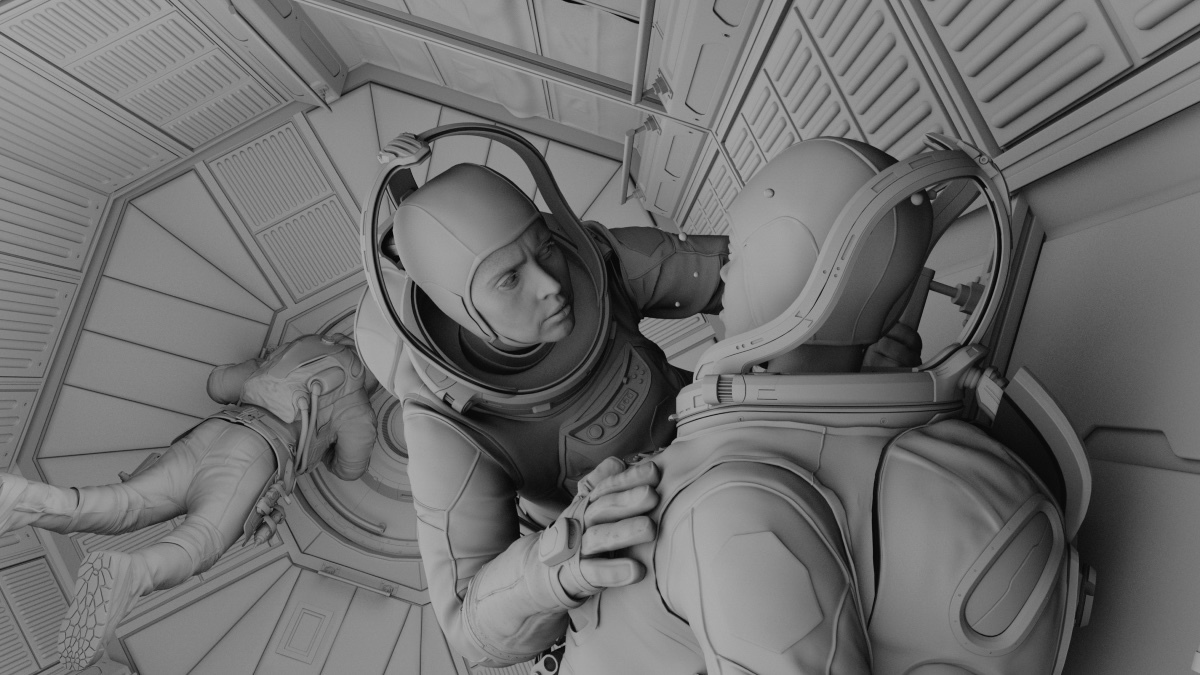
BTL: I was really impressed when I re-watched it, and I hope you’re making or already have some sort of VFX reel, which shows the different elements, because I was pretty perplexed. I did not know how much was being done with VFX vs. just being in snowy conditions.
Kasmir: Absolutely. I worked on the show, and there’s a few I struggle with. Likewise, with the Anyma Facial Capture System. Towards the end, someone said, “Is it possible to collate how many faces or how many entire performances are digital?” Off the top of my head, I thought it had to be about 10 or 15, because I was remembering the hero. There’s actually 70 fully CG characters in that space walk and in the airlock scene when SPOILER is dying. A lot of them I’d forgotten are fully CG, and I worked on it. It’s a great job Chris Lawrence did, because we had ILM coming in with this Anyma Capture Rig from San Francisco and then they were processing that data, handing off to Chris, and then he was QC’ing [quality control] that and then hand-animating the eyes for Framestore. It was a huge undertaking, and I still think now, digital doubles are one of the Holy Grails of visual effects. I just feel like we’re another step closer with this technology.
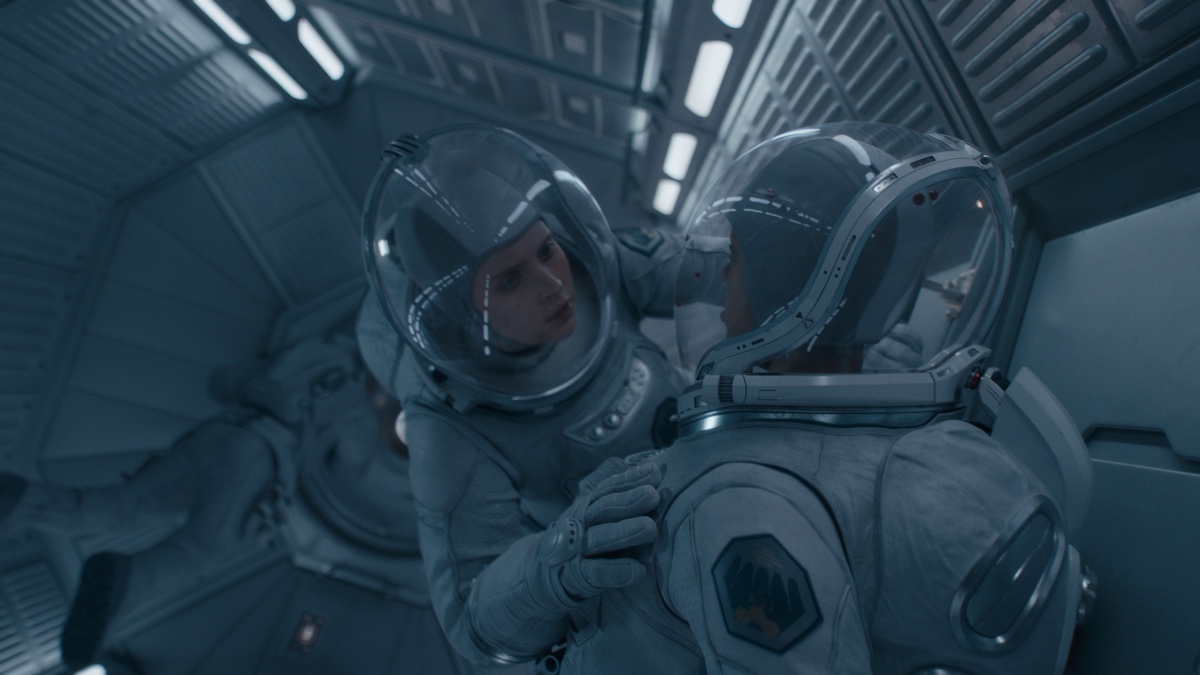
BTL: You mentioned ILM and Framestore’s involvement. Were there other Effects houses handling specific duties?
Kasmir: Yes, One of Us, which is a small boutique company in London, who do a lot of creative work, and [we’ve] always been big fans. I tasked them with a lot of the subjective briefs, I mean, like Framestore and ILM were doing “It’s an environment, it’s space. It’s X and it’s Y,” whereas One of Us were good for things like, “It’s a hologram that has to look like an old-faded photograph.” So we had these kind of immersive hologram situations for the crew to sit in to experience home life. There were other hologram rooms where you could plot a course back to Earth, which they also designed. They designed the look of K23 itself, the planet, so all of their briefs were really kind of creative and subjective, and they really lived up to the task. I mean, they had all of the current proofs that you’d normally run a mile from, and they did a great job. We also had Invisible, or Envis as they’re now called. We had them off from the very beginning, because we use their virtual camera system, then we use their simulcast system while shooting, so we could see a live overlay of the spaceship. And then, we also use them for a lot of graphic content, too, so they were our our four vendors. And everybody we picked was used to their strengths.
BTL: Obviously with a science fiction movie you expect a lot of VFX, but talking to you, I have learned that there was a lot more that wasn’t as obvious.
Kasmir: What I’m really proud of is there’s about 200, in-camera VFX shots. All of the Barbeau windows, so we didn’t have to actually… we did the first-ever in-camera composite. It was a shot of the Skidoo driving away, outside the window of Barbeau. Just for the hell of it, just to see if we could, because I knew we were gonna have an LED in London, I shot the Skidoo driving away at the right height, and at the right focal length to match the interior shots of Barbeau. And we played that on the screen and shot it live. Again, it’s going back to filmmaking. It’s something that everyone can look at and understand what we’re doing rather than having to suspend disbelief and just trust.
BTL: Great, so is there anything you’re starting to prep yet?
Kasmir: I’m still helping out George on this very small film he’s working on called The Tender Bar, and I’m currently with Eli Roth on a computer game adaptation, called Borderlands, shooting that in April. We’re in prep at the moment.
The Midnight Sky is now available on Netflix. Look for more with Matt Kasmir in our promised look at virtual production, as he talked briefly about in this interview.
All photos courtesy of Netflix except where noted. Click on images for larger version.





